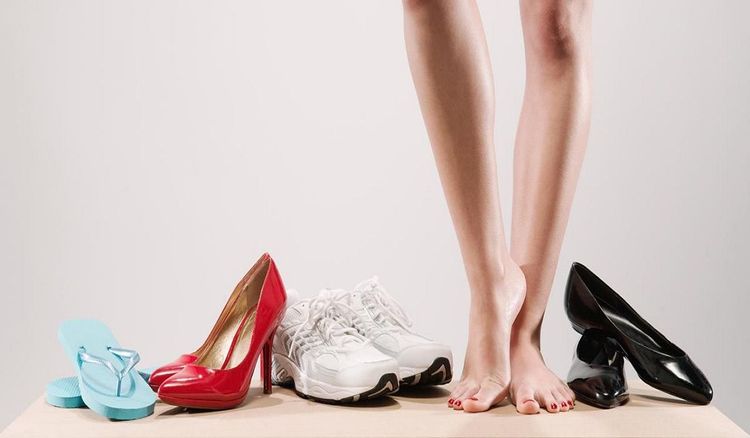For smooth Ad free experience
For smooth Ad free experience
Footwear is one of the most essential items used by humans in their day-to-day lives. Modern fashion trends like high heels or boots are considered to have evolved in the West. Yet, the evidence of sculptures and other visual sources in various sites of India show that high fashion footwear could be found in India as early as the 1st century CE.

History of Indian Footwear
We do not have an exact idea about when and how people first came up with the idea of footwear. The early cavemen of the stone age period probably did not wear any shoes or slippers and walked barefoot, even though it is hard to imagine how they must have functioned in harsh weather and terrain.
Today, it is almost impossible to picture working on our day-to-day chores without having a pair of slippers or shoes to protect our feet. Not only that, footwear in modern times, serves more than one function. We customize our footwear according to the outfit we wear or the occasion we attend. We even choose our footwear to suit the changing seasons! We wear knee-high boots in snowy winter and comfortable slippers to knock off the summer heat, action shoes for trekking and running, and heels to attend fancy events.
Wouldn't it be great to know if such customization was followed even by our ancestors? That should not be a problem because the story of footwear in India is quite a fascinating one. The diverse kinds of footwear found in India since ancient times are a reflection of the constantly changing forms of cultural influences on the subcontinent.
The earliest reference to the use of footwear comes from the Vedic Period. In the Vedic texts, including the Rig Veda, Atharvaveda, etc., the Sanskrit word for footwear 'upanah' or 'upanat' has been mentioned several times. Paduka, traditionally the oldest footwear of India, was worn by the sages and gurus in ancient times. This kind of footwear consists of a wooden sole, with a post and a knob which divides the big and the second toes.
The use of leather in footwear was prohibited during the Vedic times, because they regarded cows, the most common animal, as "aghanya" which meant that they must not be harmed or killed. Similarly, other animals were also prohibited from being killed and so the padukas during this time were made of wood and other plant products.
The padukas carried high symbolic meanings and were initially worn only by important people. The term Paduka could also mean 'footprints of deities or important people venerated'.
The pilgrims of various devotional sects today worship padukas, which they believed were worn by the saints they honour.
The Hindu epic Ramayana mentions how Bharata brought back the paduka of Sri Ram from Chitrakoot to Ayodhya and placed them on a throne. This act symbolised that Bharata was only ruling as Rama's substitute until the latter returned from his exile.
When Lord Buddha renounced his princely life to become an ascetic, he was mentioned in the scriptures as having left his footwear at home, another symbolic reference to show that footwear was an item of luxury and privilege during those times. For a long-time, people of the lower castes were not allowed to wear the padukas (or footwear in general) which clearly indicates that shoes were earlier considered a status symbol, and not a product of necessity.
Yet, it would be wrong to assume that India did not regard footwear as an important commodity, or an item of fashion. The most fascinating evidence of this comes from various visual sources from different periods, the earliest of which goes back to the 2nd century BCE!
The Chandraketugarh archaeological site of West Bengal, dating back to 400 BCE, contains the earliest evidence of flip flops/slippers/chappals.
The site is famous for its terracotta objects, including several impressive sculptures and one of them (from c.200 BCE) depicts quite a fashionable couple, flaunting, among other things, two pairs of flip flops with tiny decorative flowers!
The Kushana rulers who ruled India in the 1st century CE were depicted wearing calve length boots in the gold coins they issued under their names. The Gupta dynasty's gold coins (320-550 CE) also contain evidence of the rulers wearing high boots with stylish button-like objects in them.
Further, platform high heels, a popular fashion footwear was believed to have originated in France in the 16th century and worn by the ruthless queen, Catherine de Medici. However, a prototype of the platform heeled footwear had been known to India as early as in the 13th century CE. The Sun Temple at Konark, Orissa, built in the mid 13th century CE, contains a feminine sculpture wearing a paduka-cum-heeled shoe. Another sculpture at Ramappa Temple, Telangana, often termed the 'dancing girl', dating back to the early 13th century CE is also depicted with a pair of similar platform heels. This would mean that high heels were known to India even before they were known to the West!
0
You might be interested in reading more from
